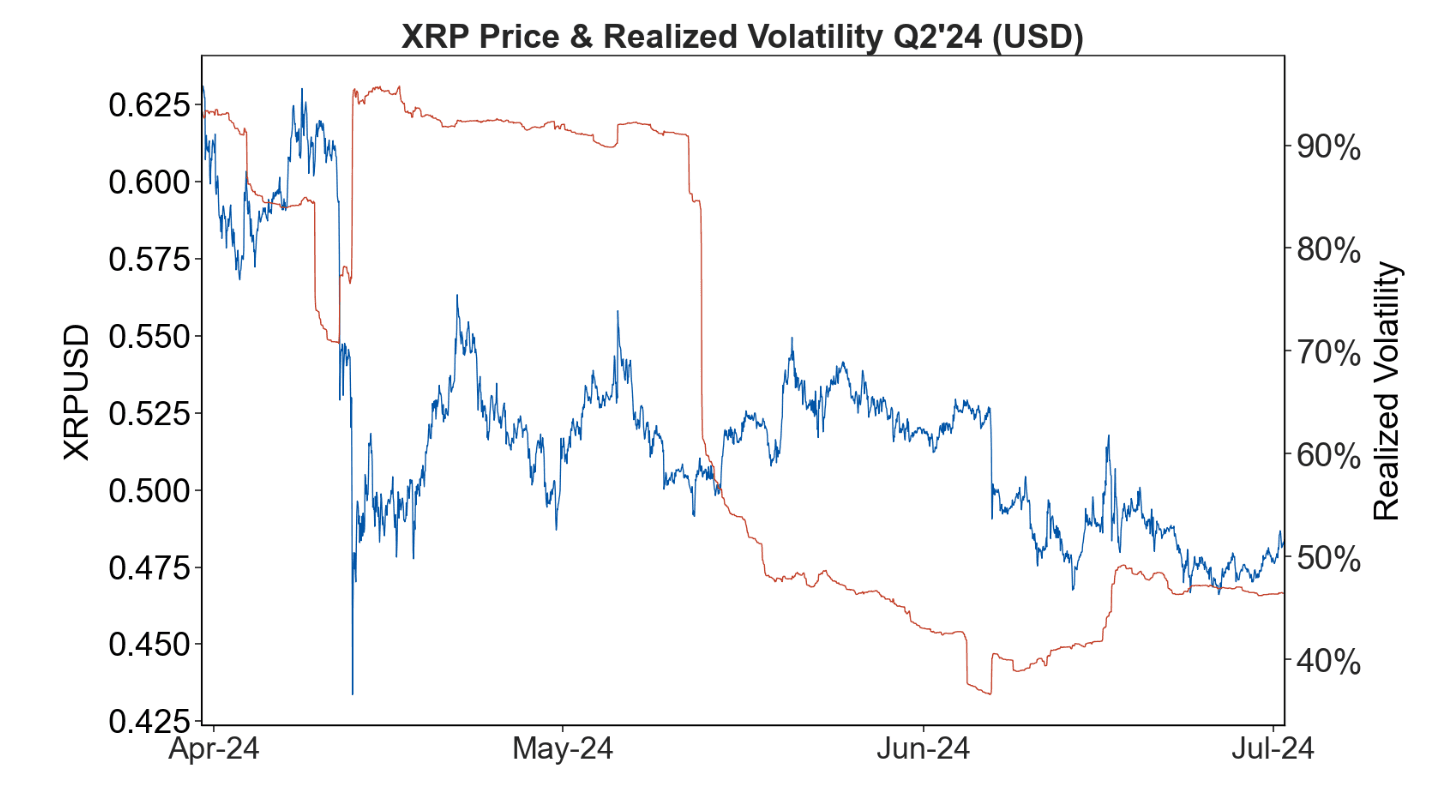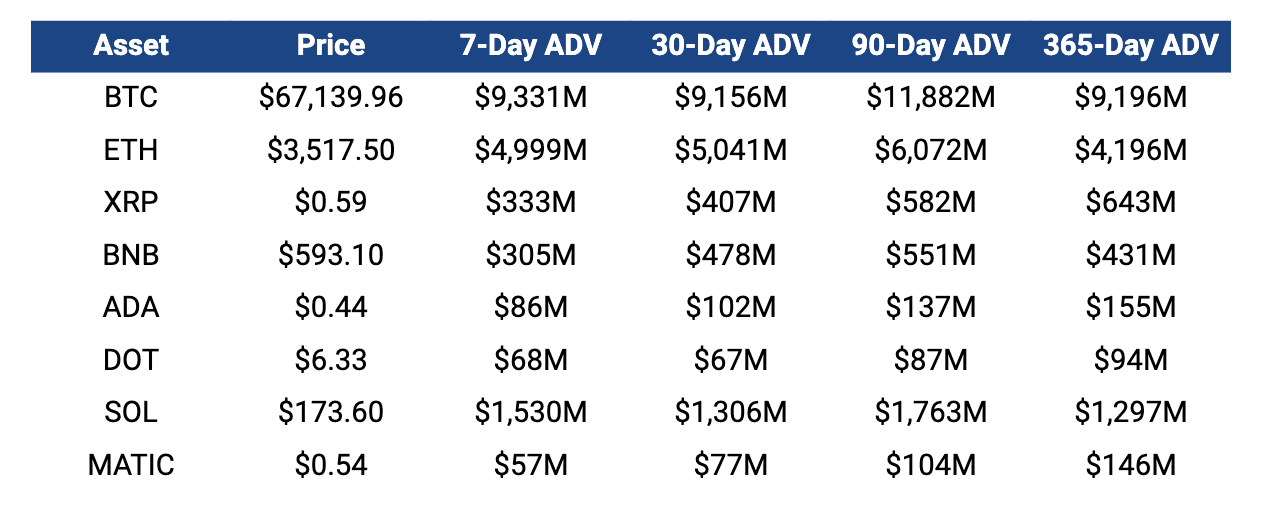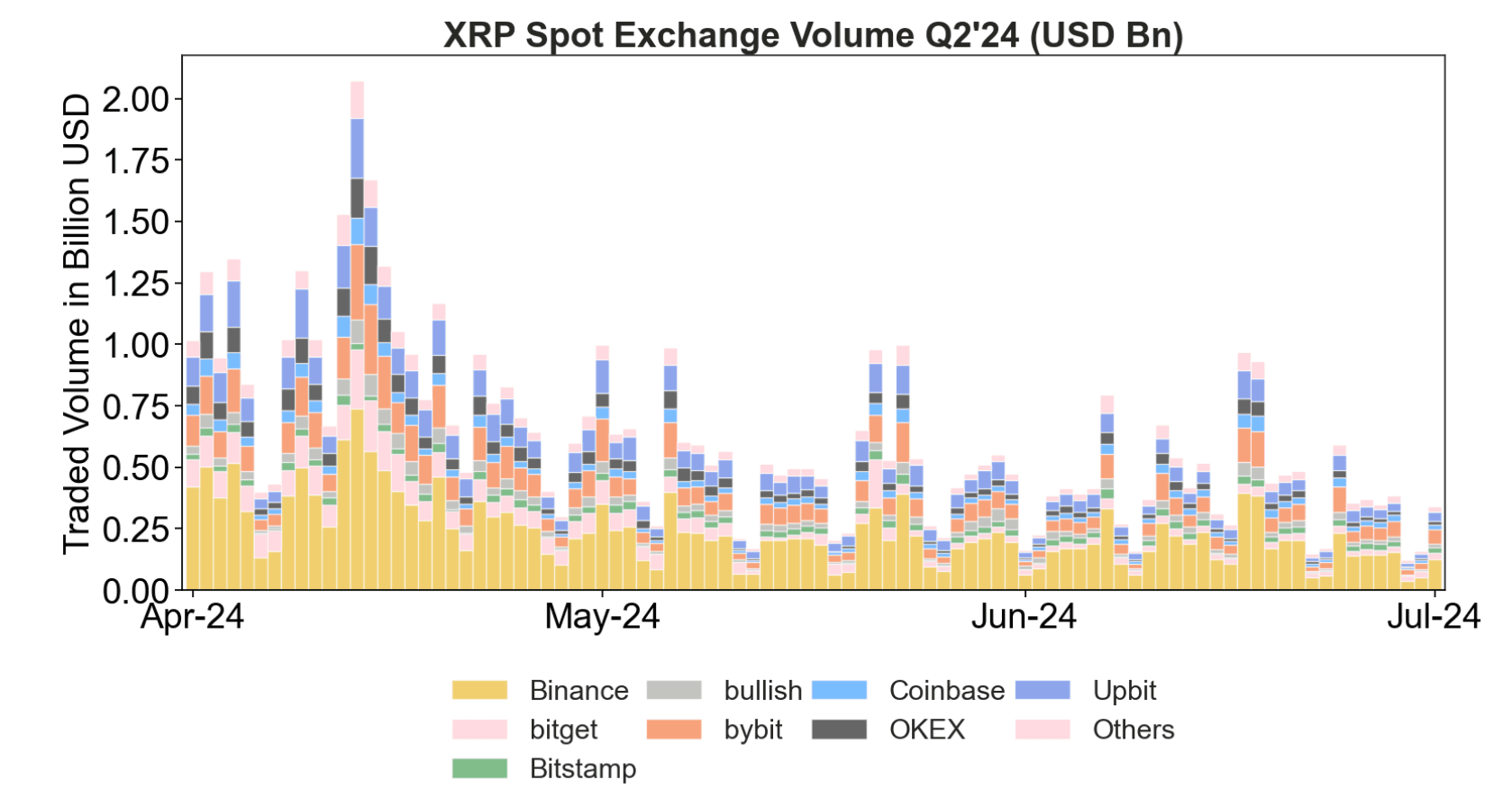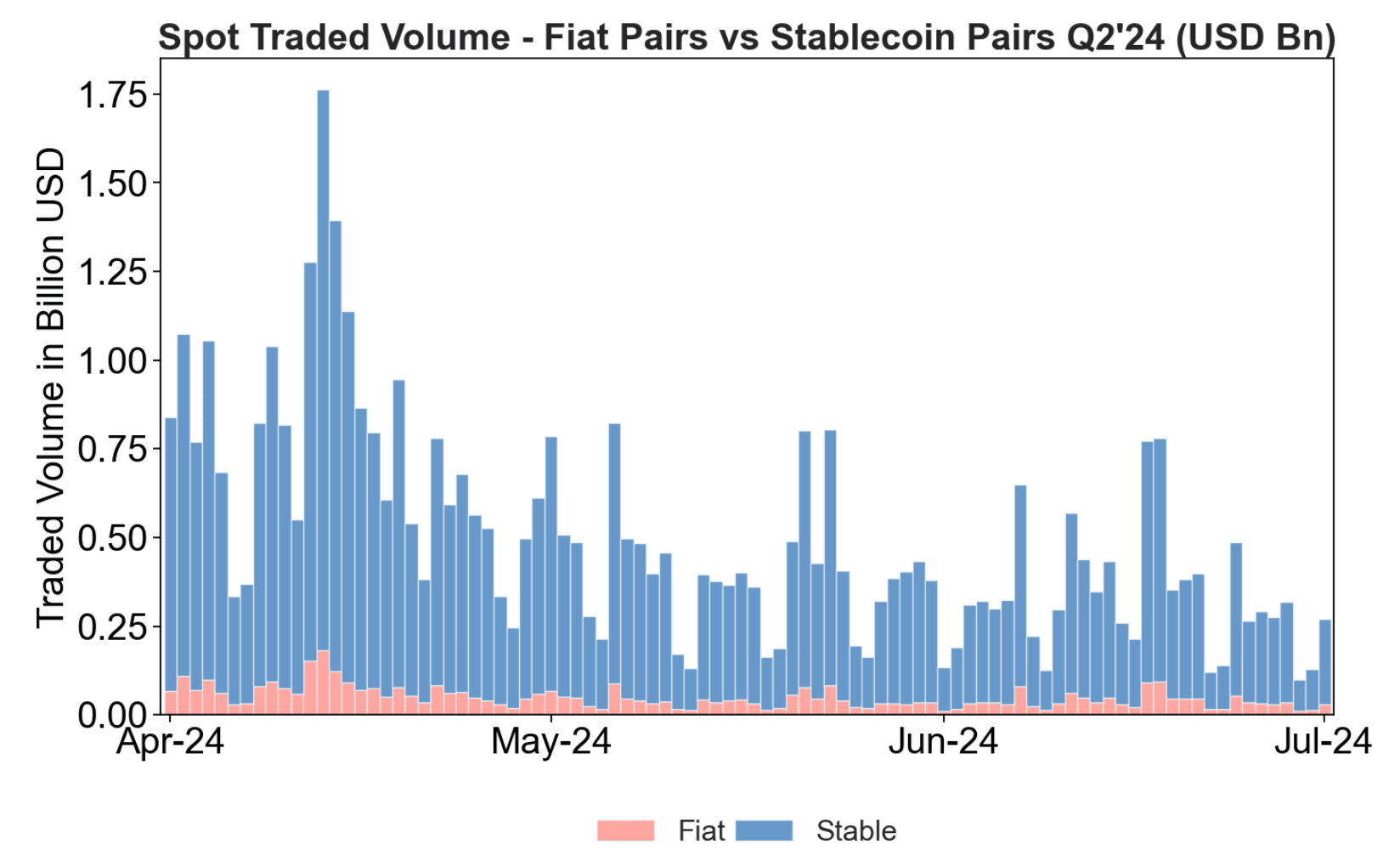Ripple publishes the quarterly XRP Markets Report to voluntarily provide transparency and regular updates on the company’s views on the state of crypto markets, relevant XRP Ledger and XRP-related announcements, and market developments over the previous quarter.
As an XRP holder, Ripple believes in proactive communication and transparency, and urges others in the industry to build trust, foster open communication, and raise the bar industry-wide.
Crypto Markets Summary
In Q2 ‘24, institutional adoption continued to be front and center with the announcement that ETH spot ETFs were greenlit for listing in the US. Many hailed it as a step in the right direction toward a more diverse and mature market, following the success of Bitcoin spot ETFs. Industry analysts predicted that this adoption may pave the way for other ETFs, such as Solana which made early advancements in an attempt to be the next spot ETF.
Later in the quarter, macroeconomic signals like inflation, interest rate expectations, and unemployment rates seemed to influence buyer and seller sentiment. BTC’s correlation to the S&P 500 climbed to 0.4 over this period (after being at 0.2 during Q4 ‘23 and Q1 ‘24). The crypto market also exhibited a “flight to quality” tendency as the industry saw smaller cap tokens experience drawdowns up to 70% while top ten market cap tokens fared better.
The overall crypto market experienced volatility after a continued rally that began in Q3 ‘23. Average daily trading volumes for BTC, ETH, and XRP fell 20% from Q1, as BTC price briefly declined below $60,000. Some reported that several factors may have influenced this including the BTC halving in April, pressure from distributions of BTC related to the decade-long Mt. Gox legal battle (>$9B), and the German government being required to sell $2.5B of BTC.
Lawsuit Wins
July 13 marked the one-year anniversary of Ripple’s landmark win against the SEC. This was a monumental moment for the industry resulting in regulatory clarity for XRP, which remains one of two digital assets that has been deemed not a security in the US. Ripple still awaits word from the court on the final piece of this case: a decision on remedies related to institutional sales before December 2020. However, the central ruling, that XRP isn't a security, won't change. Ripple remains confident that the Judge will approach this phase fairly.
Back in 2018, Ripple was first sued in a class action lawsuit in California. In June, the California Court dismissed all of the class claims based on both the federal and state laws. There is one state law claim that the plaintiff has brought as an individual (rather than as a class claim) that was not dismissed, but this individual claim is not material.
Global Regulatory Developments
The 2024 US elections will be the most consequential in crypto’s history to date and will impact the future of crypto in the US. Notably, Ripple donated $25M to Fairshake, a federal super PAC committed to supporting pro-crypto, pro-innovation political candidates, bringing the company's total contribution to $50M. This is an industry-wide, bipartisan effort to ensure there is a strong future with regulatory clarity for crypto in the US. The SEC’s repeated attempts to smother the crypto industry through enforcement actions has benefitted other key global markets that have embraced responsible innovation and economic growth.
The industry secured another win against the SEC’s crusade against crypto in Q2. In June, the SEC notified Consensys that it closed its investigation into Ethereum 2.0 and will not pursue an enforcement action. The investigation focused on the Merge and whether the transition to proof-of-stake (PoS) turned Ethereum into a securities offering. Separately, Consensys filed suit against the SEC and asked a federal court to find that Consensys neither acted as a broker nor issued securities through its software offerings MetaMask Swaps and Staking.
Globally, regulators took steps in a bid to become global crypto hubs. In Asia, Hong Kong’s financial authorities released consultation conclusions on a licensing regime for stablecoin issuers. Shortly thereafter, the HKMA announced the first participants in its stablecoin issuer sandbox including Standard Chartered Bank and web3 VC firm Animoca Brands. In Latin America, the Central Bank of Brazil announced its phased approach to unveil a regulatory framework to provide clarity for token creators and virtual asset service providers (VASPs) by the end of this year. Ripple and other industry leaders shared their perspectives on crypto regulation and how to implement a comprehensive regulatory scheme for VASPs with the Central Bank.
In the Middle East, the Central Bank of the UAE issued the Payment Token Services Regulation which aims to regulate services related to stablecoin issuance, conversion, custody and transfer. This is expected to provide clarity on the operational framework for digital assets in the UAE when it comes into force next year. And last, across Europe, the flagship Markets in Crypto-Assets regulation (MiCA) came into force for stablecoins on June 30, with Circle becoming the first global stablecoin issuer to fully comply with the MiCA regulatory framework by obtaining an EMI license from the Bank of France's Prudential Supervision and Resolution Authority. MiCA rules for other crypto assets will be implemented in December 2024.
Deep Dive: XRP Markets
For this report, Ripple uses market metrics from public sources including CCData, Bloomberg, and Refinitiv Eikon.
Chart 1:
During the first half of the second quarter, XRP exhibited elevated volatility as price reached lows of $0.43 and highs above $0.62. Realized volatility remained above 90% for most of this period. As the quarter progressed, XRP entered a more stable range, trading around the $0.5 level while realized volatility decreased by more than half, settling around 45%.

Table 1: Major Tokens Price and Volume (end of Q2‘24 figures)
USD prices and average trading volume reflects daily trading activity for the USD and stablecoin pairs on top tier exchanges as measured by CCData.

Chart 2: XRP Spot Exchange Volume
Traded volumes remained elevated throughout the first half of the quarter. Binance continued to account for a significant portion of the volume, while contributions from other exchanges varied, particularly Bybit and Upbit. The latter half of Q2 maintained consistently high traded volumes across the major exchanges.

Chart 3: XRP Spot Exchange Volume (%)
Similar to the first quarter of the year, XRP volume distribution across exchanges remained fairly constant throughout the second quarter of the year. Binance, Bybit, and Upbit were responsible for well over 65% of the total traded volume.

Chart 4: The percentage share of volume traded through fiat pairs declined from 11% in Q1 to 10% in Q2. The majority of XRP trading activity is currently against USDT.

The State of the XRP Ledger
XRPL EVM Sidechain: Enhancing Interoperability with Axelar Bridge
Last quarter, Ripple announced that the XRPL EVM sidechain will use Axelar as the exclusive bridge to source the native gas token of the sidechain (eXRP) from the XRPL. Partnering with Axelar leverages their proven expertise and related sidechain benefits while providing a secure and efficient bridge for users. Axelar can also be used to bridge other fungible tokens to and from XRPL mainnet, as well as from more than 55 blockchains in the Axelar network.
Key Amendments: Oracles and Multi-Purpose Token
Oracles on XRPL will provide institutions with access to reliable and accurate data feeds, enhancing the functionality of smart contracts and DeFi applications. Oracles will enable a wide range of use cases, from price feeds to event data, making them an essential tool for institutional DeFi. Band Protocol and DIA are oracle providers for both XRPL's mainnet and its EVM sidechain, to enable decentralized oracle price feed data, ensuring real-time market data reliability and accessibility.
Set to be release in Q3, the Multi-Purpose Token (MPT) standard will allow for the creation of complex token structures that can represent a variety of assets and rights using metadata which will be valuable for institutions looking to tokenize and manage diverse asset portfolios, ensuring efficient lifecycle management of digital assets. MPT is a token standard that will be natively available on XRPL with several capabilities that developers can directly access using simple APIs from XRPL libraries.
XRPL Integrations
Q2 saw the announcement that Archax, a digital asset exchange, broker and custodian regulated by the UK FCA, is expected to bring hundreds of millions of dollars of tokenized RWAs onto the XRPL over the coming year.
Building with the XRPL Community
Ripple announced a fund dedicated to providing support in Japan and Korea for a range of initiatives to foster innovation on the XRPL. These initiatives include developer grants, startup investments, corporate partnerships, and community growth. Japan and Korea are home to some of the most vibrant and rapidly growing XRPL communities globally, underpinned by strong institutional partnerships, progressive and proactive regulatory frameworks, and a growing number of innovative startups in the blockchain industry.
Ripple USD
Ripple announced its plans to launch a stablecoin later this year. Ripple USD will be 100% backed by US dollar deposits, short-term US government treasuries, and other cash equivalents. These reserve assets will be audited by a third-party accounting firm, and Ripple will publish monthly attestations.
While XRP is the native token on the XRPL, the XRPL was built to support any type of asset issued to trade on the DEX and quickly settle anywhere in the world with low transaction costs. Bringing credible assets on the DEX, such as Ripple USD, will drive numerous benefits for users, developers, and apps.
The stablecoin will be available on the XRP Ledger (XRPL) and Ethereum (ETH) blockchains, with plans to expand to additional blockchains and decentralized finance protocols and apps over time.
On-Chain Activity
Activity across most major protocols decreased in Q2. XRPL was no exception with on-chain activities noticeably lower in Q2 as compared to Q1.
| On-Chain Activity | Q1 2024 | Q2 2024 | QoQ |
|---|---|---|---|
| Transactions | 251,397,881 | 86,388,029 | -65.6% |
| XRP Burned for Transaction Fees | 636,183 | 495,770 | -22.1% |
| Avg Cost per Transaction (in XRP) | 0.00147 | 0.00394 | +168.03% |
| Average XRP Closing Price (in USD) | 0.56 | 0.52 | -7.1% |
| Avg Cost per Transaction (in USD) | 0.000856 | 0.002064 | +141% |
| Volume on DEX (in USD) | 64,857,084 | 37,126,655 | -42.8% |
| Trustlines | 7,376,402 | 7,325,547 | -0.6% |
| Number of New Wallets | 185,809 | 100,746 | -45.8% |
Ripple’s XRP Holdings
Ripple reports information about its XRP holdings at the beginning of the quarter and last day of the quarter. Its holdings fall into two categories: XRP that it currently has available in its wallets, and XRP that is subject to on-ledger escrow lockups that will be released each month over the next 42 months.
For this latter category, Ripple does not have access to that XRP until the escrow releases it to Ripple on a monthly basis. The vast majority of the XRP released is put back into the escrow each month.
March 31, 2024
Total XRP Held by Ripple: 4,836,166,156
Total XRP Subject to On-Ledger Escrow: 40,100,000,005
June 30, 2024
Total XRP Held by Ripple: 4,682,112,997
Total XRP Subject to On-Ledger Escrow: 39,500,000,005







